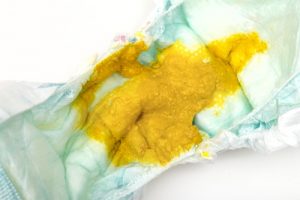A two part series on baby poo by our resident GP, Melissa.

Here is a bit of a guide to all things poo – what’s normal, what’s not and when to seek medical attention. As always, nothing replaces seeing your own doctor or midwife if there is any doubt.
I will start by saying there is such a wide range of what is normal and “normal” is always changing depending on the age and feeding mode of your baby.
As a very general rule if you have a baby who is happy, gaining weight appropriately and doesn’t have one of the few “red flag” poo abnormalities, everything is likely to be fine and within the wide range of normal (or a minor problem that is to simple treatment).
So what is NOT normal?
- Failure to pass meconium (the black tar-like poo) within the first 24 hours.
- Breastfed babies will generally do at least one poo a day in the first 6 weeks. If they don’t it is worth a review. Most commonly the reason for not doing so is inadequate intake but there are other things to consider.
- White or very pale grey poo (ALWAYS seek attention for this).
- If you have any concerns about the colour/consistency of your baby’s poo in conjunction with an unwell/miserable baby AND/OR failure to gain weight then that is always worthy of review.
Colour of baby poo
- In breastfed babies, this is usually a mustard yellow colour often with what looks like seeds or curds. It can however be more brown or greenish in colour and still be normal too.
- Formula fed babies classically have poo that looks a bit like peanut butter, but they can range from yellow to greenish to brown.
- White poo is NOT normal.
- If your baby is having iron supplements the poo may look very dark green or even black.
Blood in baby poo
- Fresh red blood, although often a cause of panic for parents is usually not caused by anything sinister in an otherwise well baby. Most common causes are:
- Split in the skin (anal fissure) or red raw excoriated nappy rash.
- Cows milk (or soy) protein intolerance. This is treated by changing to special formulas or excluding cows milk protein from the mother’s diet.
- Sometimes if mum has cracked nipples and the baby has swallowed blood.
- Other causes such as infection or serious surgical conditions are usually associated with the baby being “unwell” or having other signs.
You should always see your doctor if you notice blood in the poo but it may not be an emergency – it depends on how your baby is. For example, if they are screaming/in pain/vomiting/lethargic or in any way “unwell” or not right then you should seek medical attention straight away. Otherwise it would generally be ok to just make an appointment with your GP in the next few days.
Mucous in baby poo
This appears slime or jelly like. There may be mucous in the poo after swallowing lots of drool, during colds when they swallow a lot of their snotty secretions, or seen in infections or allergies. If there are any symptoms of your baby being unwell or if the mucous persists more than a couple of days it is worth seeing your doctor.
Consistency of baby poo
Again, there is a wide range of what is a normal consistency. It can range from quite runny to more solid. Breastfed babies tend to have looser poos than formula fed babies.
- See part 2 on constipation.
- “Diarrhoea” may be harder to distinguish as babies often have quite runny poo anyway. Signs of diarrhoea may include a definite change to more watery poo than usual, foul smell, greater frequency than usual and other associated signs such as vomiting/fever/lethargy.
- Explosive frothy poos (often with a green tinge) in unsettled babies could indicate lactose overload (not an intolerance as such, but seen when the mother has a huge milk supply and the baby gets large amounts of lactose which is a bit too much for their gut to handle. It usually settles once mum’s milk supply settles in line with the baby’s demand. Sometimes block feeding in the interim can help). The Australian Breastfeeding Association website has some good information on this.
Solids – a whole new ball game!
Do not be alarmed or surprised see great variations in poo once baby starts on solids. The consistency is usually firmer. The smell changes (and varies according to what they eat).
Don’t be concerned if you see bits of food in the nappy. For example, in my experience… blueberries are particularly offensive and often make the poo almost look black. Watermelon can look like blood. Don’t be surprised to see corn, sultanas and bits of carrot make their way through!













